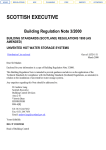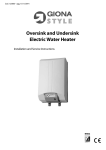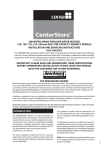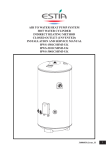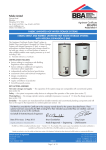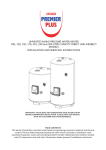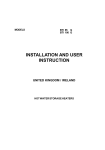Download Biasi Unvented Hot Water Cylinders Installation guide
Transcript
NEW TORNADO/TEMPEST 25336 19/4/05 12:25 PM Page 1 Tel 01952 257963 Fax 01952 253452 Furrows Business Park, Haybridge Road Wellington, Telford, Shropshire TF1 2FE www.telford-group.com WATERHEATER MANUFACTURERS ASSOCIATION NEW TORNADO/TEMPEST 25336 19/4/05 12:25 PM Page 2 STAINLESS PRODUCTS Tornado & Tempest Stainless™ Installation Guide NEW TORNADO/TEMPEST 25336 19/4/05 12:25 PM Page 3 MAINS PRESSURE DOMESTIC HOT WATER APPLIANCE STORAGE CAPACITY IN LITRES WEIGHT WHEN FULL IN KGS 90 125 150 170 200 250 300 125 165 195 220 250 310 360 STAINLESS PRODUCTS Tempest & Tornado Stainless Mains pressure domestic hot water cylinder Water Supply Pressure Max 12 Bar Min 1.5Bar Electric Immersion Heaters 14“/3kW • 230V AC Operating Pressure 3 BAR Expansion Vessel charge Pressure 3 BAR Expansion relief valve setting 5 BAR Pressure & Temperature relief valve setting WARNING TO USER: This appliance must be serviced annually by a competent person. Failure to comply with the above will invalidate the manufacturer’s warranty. Do not remove or adjust any component part of this unvented water heater: Contact the installer. If this unvented water heater develops a fault, such as a flow of hot water from the discharge pipe, switch the heater off and contact the installer. WARNING TO INSTALLER: This installation is subject to building regulation approval, notify Local Authority of intention to install. Use only manufacturer’s recommended replacement parts. 7 BAR • 90ºC Maximum Primary working Pressure Installed by: 3 BAR Name: .................................................................................. APPLIANCE SERIAL NO: Address: .............................................................................. ............................................................................................. Weight and litre capacity Ltrs Kgs Indirect Tel. No.: ............................................................................... Completion Date: ................................................................. Direct Technical help line: 01952 257961 Telford Copper Cylinders Limited Unit 22 Furrows Business Park Telford TF1 2FE 2 NEW TORNADO/TEMPEST 25336 Date 19/4/05 12:25 PM Page 4 Parts Replaced Installed and Commissioned First Annual Service Third Annual Service Fourth Annual Service Fifth Annual Service Sixth Annual Service Seventh Annual Service Eighth Annual Service Ninth Annual Service Tenth Annual Service STAINLESS PRODUCTS Engineer/ Company NEW TORNADO/TEMPEST 25336 19/4/05 12:25 PM Page 5 PROBLEM Solving: SYMPTOM No flow Low Pressure Intermittent discharge from P&T or P valve(s) Continuous discharge from P&T or P valve(s) POSSIBLE CAUSES ACTION Mains service valve not open Open stop valve or replace. Blocked filter. Clean filter in base of Pressure Reducing Valve. Service valve not fully open or partially blocked filter. Ensure service valve is fully open or clean filter in PRV. Restricted delivery pipework Replace damaged or old pipework. Low mains pressure. Check incoming mains pressure or discuss with local water supplier Expansion vessel pressure below 3.0 bar or faulty. Replenish or replace in accordance with instructions in the maintenance section. Wrongly set or faulty Inlet Pressure Reducing Valve. Replace PRV Defective expansion relief valve or debris or scale on seating of valve. Operate expansion relief valve mechanism to clear debris. If discharge does not stop replace expansion relief valve. Defective or incorrectly set cylinder thermostat (ie temperature set too high) allowing water to overheat. Check setting and operation of cylinder thermostat (55-65oC). Replace if necessary. Crossflow from uncontrolled cold water mains supply to mixer tap or shower valves. Check mixer taps and shower valve and fit check valves or area pressure controls if required. Alternatively supply cold water to mixer tap or shower valves from balanced supply position on inlet control set. Faulty expansion vessel. Recharge or replace. INDIRECT Boiler not working. Pump and/or control valve not operating. Check boiler controls. Check control functions and replace faulty parts. Cylinder thermostat upper limit stat has operated. Reset the button on the dual cylinder thermostat after investigating cause of overheating. Not enough hot water Cylinder too small. Check storage specification is adequate. Telford Service Department can help. Water not hot enough Boiler not providing enough heat. Cylinder thermostat settings incorrect. Adjust thermostat to between 55oC and 65oC. Ensure boiler thermostat is set to above 75oC. Water fails to heat DIRECT Water fails to heat Upper limit cut-out switch has operated in immersion heater. 14 Turn off electricity supply, open cap of I/H and reset cut-out (red button) or press external reset button if fitted. NEW TORNADO/TEMPEST 25336 19/4/05 12:25 PM Tornado Stainless Page 6 Tempest Stainless 3 NEW TORNADO/TEMPEST 25336 19/4/05 12:25 PM Page 7 STEP 1 Read this instruction book carefully before proceeding. A Tornado and Tempest Stainless™ cylinder is a mains pressure product and is unvented. Unvented hot water systems should only be fitted and serviced by competent persons, as defined by the current edition of the Building Regulations (England and Wales) Approved Document G or equivalent regulations. Tornado Stainless has an integrated expansion vessel. Tempest Stainless has a separate expansion vessel to reduce the height of the unit. Please verify which model you have before proceeding with the installation. The unit must be stored in an upright and dry place before installation. Only use the components supplied with the Tornado and Tempest Stainless.™ Failure to do so is potentially dangerous and will invalidate the product guarantee. The Tornado and Tempest Stainless™ should be fitted to the mains water supply through the Inlet Control Group supplied. It must only be used with a pumped primary supply and with mains quality water. The standard Tornado and Tempest Stainless™ cannot be used with solid fuel boilers. Please contact our Technical Helpline for further assistance on these applications. Tornado and Tempest Stainless™ mains pressure systems require an annual safety check by a competent person. Failure to carry out this safety check may invalidate the warranty. Use only approved DZR brass compression fittings for cylinder connections. STEP 2 Measure the area in which you plan to install the Tornado and Tempest Stainless™ and ensure that the floor can support the weight of the cylinder when full. Capacity (litres) Weight When Full (Kgs) Tornado Stainless Overall Height (mm) Tempest Stainless Overall Height (mm) External Diameter (mm) Heat Up Time 0 - 60°C (mins) Re-Heat Time to 60°C after 70% Draw Off (mins) 90 125 N/A 750 520 26 18 125 165 1350 950 520 36 25 150 195 1540 1075 520 37 26 170 220 1780 1225 520 36 25 200 250 1600 1175 570 33 24 250 310 1920 1375 570 35 25 300 360 2140 1520 570 40 29 Heat-up and re-heat times are for indirect models. All dimensions and weights are nominal. Tornado and Tempest Stainless™ is designed to work efficiently under any water flow and pressure conditions. However, the full potential of a mains pressure system is unlikely to be achieved if the flow falls below 20 1/min and the dynamic pressure is less than 1.5 bar. Telford Water Heaters can supply a range of products for improving pressures and flows if required. A minimum of 300mm clear space should be left above the Tornado Stainless for maintenance. 4 NEW TORNADO/TEMPEST 25336 19/4/05 12:25 PM Page 8 PIPE WORK LOGIC LAYOUTS S - PLAN SYSTEM CYLINDER VALVE HEATING VALVE 13 NEW TORNADO/TEMPEST 25336 19/4/05 12:25 PM Page 9 S-PLAN WIRING LAYOUT AND SYSTEMS SCHEMATIC PUMP E N L 230V/50 hz FUSED SWITCH 9 9 N N E E WIRING CENTRE 9 S/LIVE L N 2 CHANNEL TIME CONTROL E 4 5 2 N 3 E 6 7 8 1 PERM LIVE IF REQUIRED BOILER 9 10 L N NOTE 1-10 ARE LINKED E HEAT 6 HIGH LIMIT WATER DUAL CYLINDER STAT STORE 8 THE BOX NUMBERS INDICATE THE POSITION ON WIRE CENTRE COLOUR CODES BROWN = BR ORANGE = ORG GREY = GRY BLUE = N (NEUT) 4 ROOM STAT 5 EARTHS ARE NOT DRAWN INSTALL AS NECESSARY 9 8 GRY 10 CYLINDER VALVE BR ORG 2 B N NOTE THE CONTROLS PROVIDED MUST BE USED ONE IMMERSION HEATER REQUIRES A 16 AMP SUPPLY. TWO IMMERSION HEATERS REQUIRE A 32 AMP SUPPLY. FAILURE TO INSTALL WILL INVALIDATE GUARANTEE 9 5 GRY 10 2 DRAWING SHOWS “S” PLAN SYSTEM WITH DANFOSS CONTROLS 12 BR ORG B HEATING VALVE N NEW TORNADO/TEMPEST 25336 19/4/05 3 7 6 3 7 6 2 2 5 5 4 1 2 Tornado Stainless 4 1 2 12:25 PM Page 10 1 22mm Cold feed connections.* 2 22mm Boiler flow and return.* (indirect versions only). 3 22mm Hot water draw off connections.* 4 Immersion Heater (two on direct versions). 5 Position for cylinder thermostat. 6 Pressure Temperature Relief Valve. 7 Secondary return - STD on 200 - 300 litre models. *Connections 1, 2, 3 & 7 are plain pipes and require compression fittings (not supplied) Components supplied for fitting on site: Inlet Control Group (comprising of a pressure reducing valve set to 3.0 bar, single check valve, filter and expansion valve set to 5.0 bar). Cylinder thermostat (indirect models only). Factory Fitted Energy cut out valve (indirect models only). Tundish. Tempest Stainless Integrated into case of Tornado Stainless. Supplied for site fitting with Tempest Stainless. Expansion vessel (8 litre on 90 litre models, 12 litre on 125 & 150 litre models, 18L on 170 & 200 litre models, and 24 litre on 250 & 300 litre models). To prevent damage to the coil and cylinder connections, make all soldered joints before connecting pipework to the Tornado and Tempest Stainless.™ STEP 3 (all cylinders) Position the unit vertically and make the incoming cold water connection to the fitting labelled “mains water inlet”. For commissioning and later maintenance purposes it is essential to fit a service valve immediately before the connection to the Inlet Control Group. Inlet group with expansion vessel position (Tempest only) also shows drain off position and balanced supply Installing the Inlet Control Group The incoming cold water should first pass through the pressure reducing valve, which reduces the pressure to 3.0 bar - this is factory set and should not be adjusted - and then through the expansion valve (factory pre-set to 5.0 bar). The Inlet Control Group also includes a single check valve and filter. *NB Upon commissioning if the incoming pressure is less than 3.0 bar, the expansion vessel pressure, should be adjusted to 0.2 bar less than the incoming water pressure. Ensure that the Inlet Control Group is fitted immediately adjacent to the Tornado Stainless™ with the arrows on the side pointing in the same direction as the flow. It must be no further away than 500mm and have no devices or connections/draw offs between it and the cylinder. Balanced supplies for showers and mixer taps only should be taken from the appropriate connection on the Inlet Control Group (see illustration). Water regulations require that a single check valve should be fitted in the balanced draw off to prevent back flow. The inlet group supplied incorporates a single check within the body of the group. The expansion vessel for the Tempest Stainless must be fitted between the inlet control group and the unit (see illustration) A suitable means for draining the unit must be incorporated into the cold feed (see illustration) - Positioning the drain as suggested will allow a minimum of 80% of the cylinder to be drained off. 5 NEW TORNADO/TEMPEST 25336 19/4/05 12:25 PM Page 11 STEP 4 (all cylinders) Connect the discharge pipework and tundish to the valve labelled “P&T” The tundish should be connected to the cylinder using 15mm metal pipe. The tundish (supplied) must be fitted within 500mm of the outlet of the P&T valve and have at least 300mm of straight metal pipe below it, before any elbow or bend. The pipework below the tundish should be fitted in accordance with the current edition of the Building Regulations (see page 7). As a minimum this must be 22mm on all Tornado and Tempest Stainless™ models. The discharge from the expansion valve on the Inlet Control Group must be connected into the discharge pipe work. For good practice purpose a double check valve should be fitted to the hot water draw off to prevent any back pressure. STEP 5 (indirect cylinders only) Connect the boiler flow and return to the labelled connections. Before making the connections ensure that the coil is free from obstructions by blowing through it. The Energy Cut Out valve is an essential part of the safety requirements for indirect mains pressure cylinders and should be installed on the primary flow to the cylinder with port ‘B’ (embossed on side of valve body) to the cylinder. The valve will open and close on receiving a signal from the cylinder thermostat. No further control is required for the hot water in a two zone valve system. This valve must also be used in a flow share (Y Plan) system, in conjunction with the mid-position valve, to act as a safety cut out valve. The cylinder thermostat controls the temperature of the hot water and also acts as an emergency cut out in the event that the boiler temperature controls fail. The cylinder thermostat is fitted into the pocket labelled “Store Temp Control” in the cylinder, and should be connected to operate the energy cut out valve in accordance with the wiring diagram for the scheme being installed (see pages 12 and 13). STEP 6 (all cylinders) Connect hot water draw off to connection labelled “Hot Water Taps”. NB: If the secondary circulation system contains more than 15 litres of water a separate expansion vessel must be provided to compensate for the larger stored volume. 6 NEW TORNADO/TEMPEST 25336 19/4/05 12:25 PM Page 12 Lifetime Guarantee: The Stainless™ steel vessel carries a lifetime guarantee against faulty manufacture or materials, provided that: The product is used solely for the storage of mains quality potable water. The product has not been modified or tampered with. The product has been installed and maintained in accordance with the installation instructions. The product has not been subjected to damage caused by frost, or other external influence. The Guarantee Card, supplied with the product, has been completed and returned to Telford Water Heaters within 90 days of installation. The immersion heater, water control valves, cylinder thermostat and energy cut out valves are guaranteed for two years from the date of manufacture. This guarantee is only available in the United Kingdom of Great Britain and Northern Ireland. Claims made against our Lifetime Guarantee must be supported with evidence of purchase and the product serial number, along with a copy of the completed Benchmark Log Book. Your Statutory rights are not affected by this guarantee. Exclusions to the guarantee Any labour charges associated wih replacement of the unit or any of its components. Any consequential losses caused by malfunction or failure of the unit. The effects of scale build up. Failure to carry out the annual safety check on this product will invalidate the guarantee. 11 NEW TORNADO/TEMPEST 25336 19/4/05 12:25 PM Page 13 NOTES ON WATER QUALITY AND SCALING: Water hardness can vary considerably around the country. If furring of kettles normally occurs in the area, then the unit should be fed with conditioned water only. This can be provided by a water softener with a high capacity flow rate, or a suitable water conditioner (not supplied). It is recommended that the temperature controls are set below 650C to prevent lime scale build up. The performance of all water storage appliances and their associated components may deteriorate if you do not protect adequately against hard water scaling. If more than 150ppm salts are present in local water samples, an effective conditioner should always be used. MAINTENANCE: The following checks should be conducted annually: Check the operation of the T & P valve and Expansion valve by rotating the heads of the valves in turn until water is discharged. The discharge should stop immediately when the valve head is released. Should this not be the case the valve should be replaced. Check that the discharged water flows freely to waste and that there is no blockage. Remove and clean the filter in the Pressure Reducing Valve. The expansion vessel does not require any routine maintenance, however it is advisable to check annually that the pre-charge pressure is 3.0 bar. However, if water is being discharged from the expansion valve it may be indicative of pressure loss within the expansion vessel itself. To check the pressure, isolate the unit from the cold supply and release any pressure by opening a hot tap until water stops flowing. Then use a tyre pressure gauge to verify the pre-charge pressure. The vessel is factory pre-charged to 3.0 bar. If the pressure is less than this it can be re-pressurised to 3.0 bar using a suitable pump. If the unit is more than 5 years old when this problem is experienced it may be advisable to replace the pressure vessel. If however, the pressure in the expansion vessel is 3.0 bar, the discharge may be being caused by back pressure or cross-over between the cold and hot water supplies - see below. To replace the pressure vessel, unscrew from threaded connection. The new pressure vessel should be checked to ensure it has a pre-charge of 3.0 bar, and then fitted to the cylinder, ensuring that the threads are sealed appropriately. Checking for back pressure Back pressure from a faulty or uncontrolled mixer valve or appliance will cause the cylinder to over pressurise and may result in water being discharged from the expansion valves. To check for back pressure follow the steps below: Turn off cold water supply to cylinder, whilst leaving cold supply to all mixer taps and appliances connected. Open a single hot tap, and run water for several minutes to dissipate any pressure in the cylinder, the pressure on the gauge should be allowed to fall below 1 bar. In turn open both the hot and cold taps on mixer valves and watch pressure on gauge. The pressure will rise once the faulty mixer valve is opened as it will allow higher pressure cold water back into the cylinder. The faulty mixer should then be replaced. NB: A suitable gauge fitted to a hot tap will be needed for Tempest Stainless Models. Use only genuine Telford replacement parts on all repairs. 10 NEW TORNADO/TEMPEST 25336 19/4/05 12:25 PM Page 14 STEP 7 (all cylinders) Make electrical connections to the immersion heaters - see wiring diagram inside cap of immersion heater. All electrical installations must be to IEE standards. The immersion heaters fitted to the Tornado and Tempest Stainless™ cylinder are of a special construction and include both a control thermostat and overheat protection. Only use genuine replacement parts which can be obtained from a Telford Water Heaters approved merchant. Ensure that the immersion heater control setting is set between 55°C and 65°C for economical operation. The upper limit thermostat is pre-set to 80oC and must not be tampered with. STEP 8 Commissioning & Operating Ensure all connections are fully tightened. Open all of the hot taps supplied by the cylinder and slowly fill the unit by opening the service valve. Continue to fill the unit until water runs continuously from all of the open taps. Open the service valve fully, and close all hot taps. Check for leaks. Heat the water to 60oC. Once the desired temperature has been reached, the cylinder should be isolated and drained to flush out any flux/solder introduced during the installation process. The filter in the inlet control set should be removed, cleaned and re-fitted - see photograph. Reheat the cylinder to desired temperature and recheck for leaks. For safety and energy saving reasons it is advisable to operate the Tornado Stainless™ at a temperature between 55°C and 60°C. The boiler thermostat (indirect models only) should be set to 75°C, or above, to achieve the best performance from the Tornado Stainless™. STEP 9 Remove the protective film from the outer case of the Tornado Stainless™ and wipe down. Place this instruction book in a convenient place for the end user. Complete the Benchmark Log Book and guarantee card and leave with the cylinder. 7 NEW TORNADO/TEMPEST 25336 19/4/05 12:25 PM Page 15 Discharge - Building Regulations: Discharge pipes must be installed in accordance with the latest edition of the Building Regulations. Discharge Pipes The discharge pipe (D1) from the vessel up to and including the tundish is generally supplied by the manufacturer of the hot water storage system (see paragraph 3.5). Where otherwise, the installation should include the discharge pipe(s) (D1) from the safety device(s). In either case the tundish should be vertical, located in the same space as the unvented hot water storage system and be fitted as close as possible and within 500mm of the safety device e.g. the temperature relief valve. The discharge pipe (D2) from the tundish should terminate in a safe place where there is no risk to persons in the vicinity of the discharge, be of metal and: a. be at least one pipe size larger than the normal outlet size of the safety device unless its total equivalent hydraulic resistance exceeds that of a straight pipe 9m long i.e. discharge pipes between 9m and 18m equivalent resistance length should be at least two sizes larger than the nominal outlet size of the safety device, between 18 and 27m at least 3 sizes larger, and so on. Bends must be taken into account in calculating the flow resistance. Refer to Diagram 1, Table 1 and the worked example. An alternative approach for sizing discharge pipes would be to follow BS 6700: 1987 Specification for design installation, testing and maintenance of services supplying water for domestic use within buildings and their curtilages, Appendix E, section E2 and table 21. b. have a vertical section of pipe at least 300mm long, below the tundish before any elbows or bends in the pipework. c. be installed with a continuous fall. d. have discharges visible at both the tundish and the final point of discharge but where this is not possible or is practically difficult there should be clear visibility at one or other of these locations. Examples of acceptable discharge arrangements are: i. ideally below a fixed grating and above the water seal in a trapped gully. ii. downward discharges at low level; i.e. up to 100mm above external surfaces such as car parks, hard standings, grassed areas etc. are acceptable providing that where children may play or otherwise come into contact with discharges a wire cage or similar guard is positioned to prevent contact, whilst maintaining visibility. iii. discharges at high level; e.g. into a metal hopper and metal down pipe with the end of the discharge pipe clearly visible (tundish visible or not) or onto a roof capable of withstanding high temperature discharges of water and 3 m from any plastics guttering system that would collect such discharges (tundish visible). iv. where a single pipe serves a number of discharges, such as in blocks of flats, the number served should be limited to not more than 6 systems so that any installation discharging can be traced reasonably easily. The single common discharge pipe should be at least one pipe size larger than the largest individual discharge pipe (D2) to be connected. If unvented hot water storage systems are installed where discharges from safety devices may not beapparent i.e. in dwellings occupied by blind, infirm or disabled people, consideration should be given to the installation of an electronically operated device to warn when discharge takes place. Note: The discharge will consist of scalding water and steam. Asphalt, roofing felt and non-metallic rainwater goods may be damaged by such discharges. 8 NEW TORNADO/TEMPEST 25336 DIAGRAM 1 See para 3.9 19/4/05 12:26 PM Page 16 - Typical discharge pipe arrangement metal discharge pipe (D1) from temperature relief valve to tundish safety device (e.g. temperature relief valve) tundish 300mm minimum Discharge below fixed grating (3.9d gives alternative points of discharge) metal discharge pipe (D2) from tundish, with continuous fall. See 3.9d i-iv, Table 1 and worked example trapped gully Table 1 - Sizing of copper discharge pipe ‘D2’ for common temperature relief valve outlet sizes Valve Outlet Size Minimum Size of Discharge pipe D1* Minimum Size of Discharge Pipe D2* from tundish Maximum resistance allowed, expressed as a length of straight pipe (i.e. no elbows or bends) Resistance created by each elbow or bend G1/2 15mm G3/4 22mm G1 28mm 22mm 28mm 35mm 28mm 35mm 42mm 35mm 42mm 54mm up to 9m up to 18m up to 27m up to 9m up to 18m up to 27m up to 9m up to 18m up to 27m 0.8m 1.0m 1.4m 1.0m 1.4m 1.7m 1.4m 1.7m 2.3m *see 3.5, 3.9, 3.9(a) and Diagram 1 Worked Example:The example below is for a G1/2 temperature relief valve with a discharge pipe (D2) having 4 no. elbows and length of 7m from the tundish to the point of discharge. From Table 1: Maximum resistance allowed for a straight length of 22mm copper discharge pipe (D2) from a G1/2 temperature relief valve is: 9.0m. Subtract the resistance for 4 No. 22mm elbows at 0.8m each = 3.2m Therefore the maximum permitted length equates to: 5.8m. 5.8m is less than the actual length of 7m therefore calculate the next largest size. Maximum resistance allowed for a straight length of 28mm pipe (D2) from G1/2 temperature relief valve equates to: 18m. Subtract the resistance for 4 No. 28mm elbows at 1.0m each = 4m. Therefore the maximum permitted length equates to 14m. As the actual length is 7m, a 28mm (D2) copper pipe will be satisfactory. 9


















